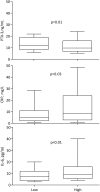Inverse relationship between the inflammatory marker pentraxin-3, fat body mass, and abdominal obesity in end-stage renal disease
- PMID: 22157708
- PMCID: PMC3255358
- DOI: 10.2215/CJN.02320311
Inverse relationship between the inflammatory marker pentraxin-3, fat body mass, and abdominal obesity in end-stage renal disease
Abstract
Background and objectives: Pentraxin-3 (PTX3) belongs to the same pentraxin superfamily of acute-phase reactants as C-reactive protein (CRP). Abdominal fat accumulation in ESRD is considered a chronic inflammatory state, but the relationship of PTX3 to this phenomenon is unknown. This study assesses plausible associations between PTX3 and surrogates of fat mass deposits in dialysis patients.
Design, setting, participants, & measurements: Circulating levels of PTX3, CRP, and IL-6 were cross-sectionally analyzed in relation to anthropometric and nutritional surrogate markers of fat tissue in two cohorts comprising 156 prevalent hemodialysis (HD) and 216 incident dialysis patients.
Results: In both cohorts, PTX3 was negatively associated with body mass index (BMI) and fat body mass index (FBMI) derived from anthropometrics and leptin, whereas there was a positive association with adiponectin. In prevalent HD patients, those with larger waist circumference (above gender-specific median values) had lower PTX3, higher CRP, and higher IL-6 levels. This was also true in multivariate analyses. In both cohorts, multivariate regression analyses showed that PTX3 was negatively and CRP (or IL-6) was positively associated with FBMI.
Conclusions: Although CRP and IL-6 were directly associated with body fat, PTX3 levels showed negative correlations with surrogates of adipose tissue in two independent cohorts of ESRD patients. Understanding the underlying reasons behind these opposite associations may have clinical relevance given the survival advantage described for obese patients on dialysis.
Figures

Similar articles
-
Associations of Body Mass Index and Body Fat With Markers of Inflammation and Nutrition Among Patients Receiving Hemodialysis.Am J Kidney Dis. 2017 Dec;70(6):817-825. doi: 10.1053/j.ajkd.2017.06.028. Epub 2017 Sep 1. Am J Kidney Dis. 2017. PMID: 28870376
-
Obesity and high waist circumference are associated with low circulating pentraxin-3 in acute coronary syndrome.Cardiovasc Diabetol. 2013 Nov 11;12:167. doi: 10.1186/1475-2840-12-167. Cardiovasc Diabetol. 2013. PMID: 24215445 Free PMC article.
-
Usefulness of the conicity index together with the conjoint use of adipocytokines and nutritional-inflammatory markers in hemodialysis patients.J Physiol Biochem. 2017 Feb;73(1):67-75. doi: 10.1007/s13105-016-0525-1. Epub 2016 Oct 13. J Physiol Biochem. 2017. PMID: 27734324
-
The Potential Role of Aerobic Exercise-Induced Pentraxin 3 on Obesity-Related Inflammation and Metabolic Dysregulation.Mediators Inflamm. 2017;2017:1092738. doi: 10.1155/2017/1092738. Epub 2017 Mar 17. Mediators Inflamm. 2017. PMID: 28400677 Free PMC article. Review.
-
Pentraxin 3 concentration is associated with poor outcomes in patients with coronary artery disease: a systematic review and dose-response meta-analysis.Acta Cardiol. 2022 Jul;77(5):385-394. doi: 10.1080/00015385.2021.1948715. Epub 2021 Jul 20. Acta Cardiol. 2022. PMID: 34281479
Cited by
-
Novel association between serum pentraxin-2 levels and advanced fibrosis in well-characterised patients with non-alcoholic fatty liver disease.Aliment Pharmacol Ther. 2015 Sep;42(5):582-90. doi: 10.1111/apt.13292. Epub 2015 Jun 29. Aliment Pharmacol Ther. 2015. PMID: 26119353 Free PMC article.
-
PTX3 in serum induces renal mesangial cell proliferation but has no effect on apoptosis.Exp Ther Med. 2018 Feb;15(2):1193-1198. doi: 10.3892/etm.2017.5521. Epub 2017 Nov 16. Exp Ther Med. 2018. PMID: 29434706 Free PMC article.
-
The obesity paradox: A further consideration in dialysis patients.Semin Dial. 2019 Nov;32(6):485-489. doi: 10.1111/sdi.12834. Epub 2019 Jul 23. Semin Dial. 2019. PMID: 31338891 Free PMC article.
-
Association of Plasma Pentraxin-3 Level with Lipid Levels and Cardiovascular Risk Factors in People with No History of Lipid-Lowering Medication: the Dong-gu Study.J Atheroscler Thromb. 2019 Aug 1;26(8):738-745. doi: 10.5551/jat.47167. Epub 2019 Jan 23. J Atheroscler Thromb. 2019. PMID: 30674758 Free PMC article.
-
Pentraxin-3 Attenuates Renal Damage in Diabetic Nephropathy by Promoting M2 Macrophage Differentiation.Inflammation. 2015 Oct;38(5):1739-47. doi: 10.1007/s10753-015-0151-z. Inflammation. 2015. PMID: 25761429
References
-
- de Koning L, Merchant AT, Pogue J, Anand SS: Waist circumference and waist-to-hip ratio as predictors of cardiovascular events: Meta-regression analysis of prospective studies. Eur Heart J 28: 850–856, 2007 - PubMed
-
- Hotamisligil GS: Inflammation and metabolic disorders. Nature 444: 860–867, 2006 - PubMed
-
- Witasp A, Carrero JJ, Heimburger O, Lindholm B, Hammarqvist F, Stenvinkel P, Nordfors L: Increased expression of pro-inflammatory genes in abdominal subcutaneous fat in advanced chronic kidney disease patients. J Intern Med 269: 410–419, 2011 - PubMed
-
- Zoccali C, Mallamaci F: Does adipose tissue have a key role in inflammation in CKD? J Intern Med 269: 407–409, 2011 - PubMed
-
- Cordeiro AC, Qureshi AR, Stenvinkel P, Heimburger O, Axelsson J, Barany P, Lindholm B, Carrero JJ: Abdominal fat deposition is associated with increased inflammation, protein-energy wasting and worse outcome in patients undergoing haemodialysis. Nephrol Dial Transplant 25: 562–568, 2010 - PubMed
Publication types
MeSH terms
Substances
LinkOut - more resources
Full Text Sources
Medical
Research Materials
Miscellaneous

